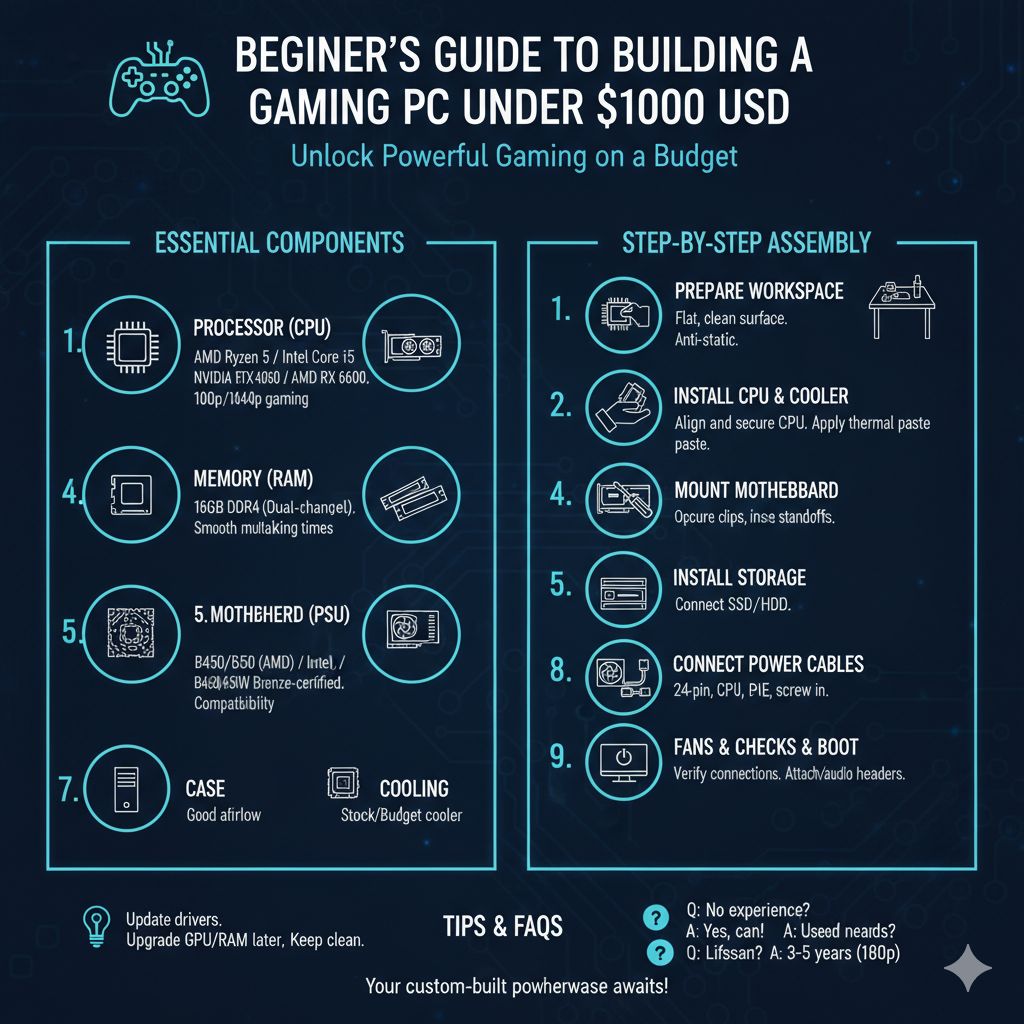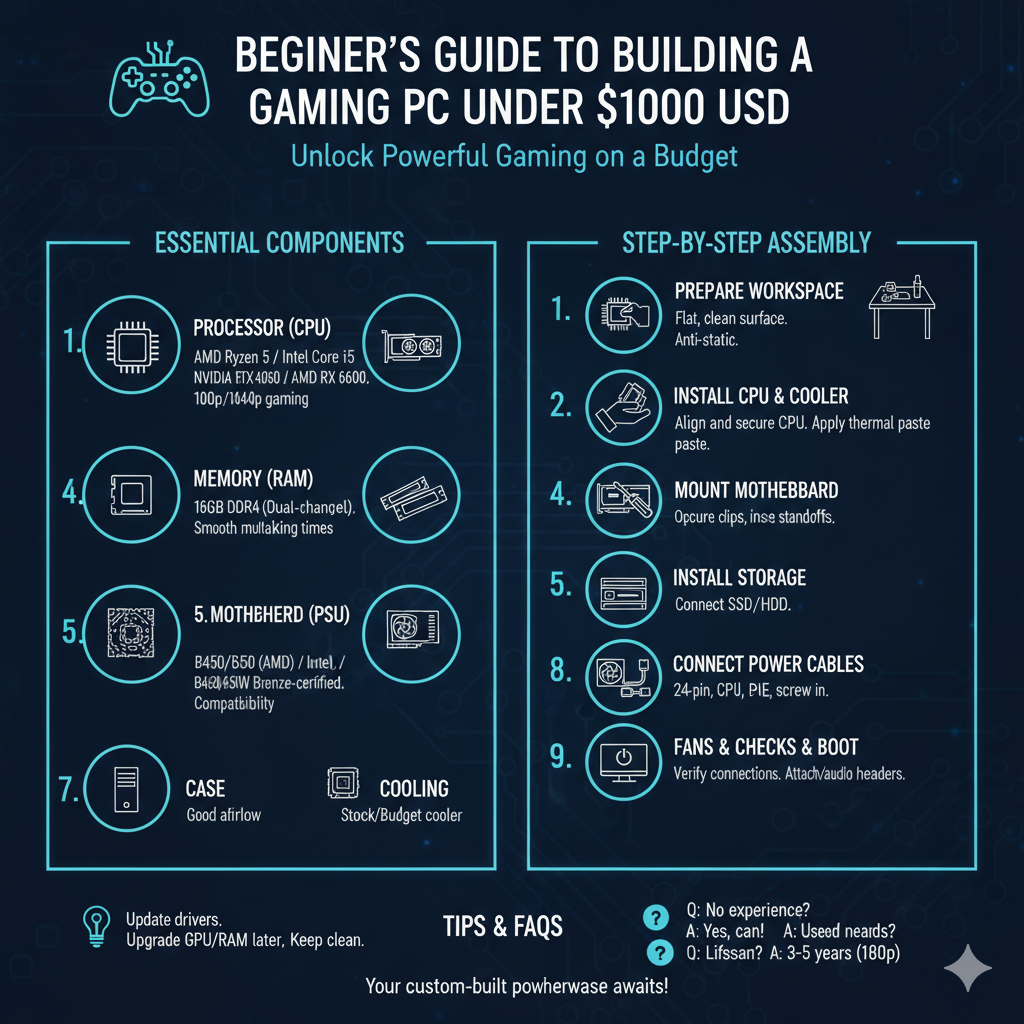Building a gaming PC for under 1000 USD is totally possible and a great way to get a powerful machine without breaking the bank. Whether you want to play popular games smoothly or just want a solid system for the next few years, this guide walks you through the essentials step-by-step.
Why Build a Gaming PC?
Building your own gaming PC lets you customize parts, save money, and upgrade easily over time. Prebuilt systems often come with hidden costs and lower-quality parts. With your own build, you get better performance for your budget.
What You’ll Learn in This Guide
- How to pick components for gaming performance on a budget
- Basic tools and workspace setup
- Step-by-step assembly tips
- Tips on upgrading and optimizing your gaming PC
- Answers to beginner questions Planning Your Gaming PC Build on a Budget Set a Clear Budget: Under 1000 USD
It’s important to stick close to the 1000 USD mark by choosing parts that offer great value. Prioritize components that directly affect gaming performance like the CPU and graphics card.
Use These Long-Tail Keywords for Research
To find the best deals and guides, search with these keywords:
- best budget gaming PC build under 1000 USD
- how to build a gaming PC under 1000 for beginners
- affordable gaming PC parts list 2025
- gaming PC build for 1080p under 1000
- best CPU for gaming PC under 1000 dollars
- budget GPU for gaming PC 1000 USD
- best RAM for gaming under 1000
- top motherboards for budget gaming PC
- building a gaming computer step-by-step
- how to build a PC for gaming for beginners
- tips for building gaming PC on low budget
- gaming PC storage options under $1000
- cheapest gaming PC build with good FPS
- best cooling options for budget gaming PC
- mid-range gaming PC build 2025 under $1000
- upgrading components in budget gaming builds
- building a PC for esports games on a budget
- best SSD for gaming PC budget build
- tips to avoid mistakes building a gaming PC
- affordable gaming PC setup for new gamers Essential Gaming PC Components
- Processor (CPU)
The CPU is the heart of your gaming PC. For under 1000 USD, a mid-range model like AMD Ryzen 5 or Intel Core i5 offers excellent gaming performance without overspending.
- Graphics Card (GPU)
A good GPU is critical for gaming. Consider cards like the NVIDIA RTX 4060 or AMD Radeon RX 6600. They balance price and power well for 1080p and some 1440p gaming.
- Memory (RAM)
Aim for at least 16GB DDR4 RAM for smooth multitasking and gaming performance. Dual-channel kits are better than a single stick.
- Storage
Use an SSD (at least 500GB) for fast loading times. NVMe M.2 SSDs offer better speeds than SATA SSDs but may cost slightly more.
- Motherboard
Choose a motherboard compatible with your CPU that supports future upgrades. B450 or B550 chipsets for AMD Ryzen, or B660/B760 for Intel, are good budget choices.
- Power Supply Unit (PSU)
Don’t cheap out on PSU. A quality 550-650W bronze-certified PSU ensures stable power delivery and protects your components.
- Case
Pick a case with good airflow and enough room for your components. Budget-friendly cases with airflow fans included are ideal.
- Cooling
Stock coolers work for many CPUs, but extra case fans or a budget aftermarket cooler can help with temperatures and noise.
Tools and Workspace Setup for Beginners
- Phillips-head screwdriver (#2 size recommended)
- Clean, flat surface with plenty of light
- Anti-static wrist strap (optional but recommended)
- Small containers to keep screws organized
- Patience and reading manuals for your parts Step-by-Step Building Process Step 1: Prepare Your Workspace
Lay out all your parts and tools in an organized way. Ground yourself to avoid static electricity damage.
Step 2: Install the CPU on the Motherboard
Carefully open the CPU socket latch. Align the CPU’s marked corner with the socket. Place gently and lock it in place. Apply thermal paste if needed before fixing the cooler.
Step 3: Install RAM
Open the RAM slots by pushing the clips outward. Insert RAM sticks evenly and press firmly until the clips snap back.
Step 4: Mount the Motherboard into the Case
Secure the motherboard onto case standoffs with screws. Be sure all ports align with the case’s back panel.
Step 5: Install Storage Drives
Insert SSD or HDD into the storage bays. Connect with SATA or M.2 ports on the motherboard.
Step 6: Install the Graphics Card
Slot the GPU into the PCIe x16 slot on the motherboard. Screw it firmly to the case.
Step 7: Connect Power Supply Cables
Attach the 24-pin motherboard cable, CPU 4/8-pin power, and GPU power cables. Manage cables neatly for airflow.
Step 8: Add Case Fans and Front Panel Connectors

Connect fans to motherboard headers or PSU. Attach USB, audio, and power buttons from the case front panel to the motherboard headers according to the manual.
Step 9: Final Checks and Boot
Double-check all connections. Close the case and plug in keyboard, mouse, and monitor. Power on and enter BIOS to verify hardware recognition.
Tips to Optimize and Upgrade Your Gaming PC
- Update BIOS and drivers regularly for best performance.
- Consider adding more RAM or switching to faster SSDs later.
- Upgrade GPU when budget allows for better gaming graphics.
- Keep your PC clean and dust-free to avoid overheating.
- Watch YouTube tutorials for visual help on build steps. Common Beginner Questions Answered
Q: Can I build a gaming PC with no experience?**
A: Absolutely. With patience and guides like this, beginners can build a great gaming PC under 1000 USD.
Q: Should I buy used parts to save money?**
A: You can, but new parts ensure warranty and reliability. Used parts require caution and testing.
Q: How long will this PC last for gaming?**
A: A well-built PC under 1000 USD can run most games at 1080p for 3-5 years with occasional upgrades.
Building a gaming PC under 1000 USD is an exciting project that saves money and delivers excellent gaming experiences. Follow this easy guide, choose parts wisely, and enjoy your custom-built powerhouse!



